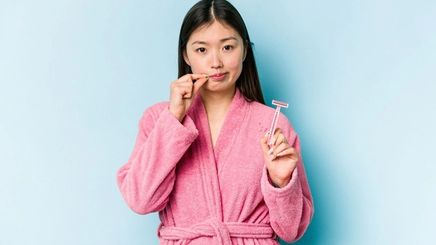
While the term "peach fuzz" may sound cute, it is something many people want out of their lives – especially if it's on the face. While there is absolutely nothing wrong with having it, many choose to remove the hair with dermaplaning. Read on to learn about peach fuzz and some essential dos and don’ts on removing facial hair growth.
What Is Peach Fuzz?
Peach fuzz – also called vellus hair – are tiny, translucent hairs that grow on your face, neck, back, arms, and legs. These short hairs help the body by providing protection from irritants and regulating body temperature. It helps cool us down with sweat and insulates us when things get chilly. Everyone has peach fuzz; it’s just more noticeable with certain people.
Many who feel self-conscious about it worry that it prevents their skin from looking its best. Some also get teased for “having a beard,” which, of course, is false. Beard hair is coarser and darker, while vellus hair is fine, soft, and usually translucent. Because of its texture and color, removing peach fuzz from your face may be a little tricky.
How Do You Take Care of Peach Fuzz?
Peach fuzz is normal and there is really no need to "take care" of it, but you can keep your hair follicles from clogging with gentle cleansing and regular exfoliation. If you're asking, "Is it okay to pluck peach fuzz?" It isn't advisable since there may be too much hair and trying to remove them all by plucking can irritate the skin. Most people go for in-office treatments like dermaplaning to get rid of facial hair growth.
What is Dermaplaning?
Dermaplaning is a resurfacing procedure that removes the top layers of skin. It is a non-invasive treatment you can do at your dermatologist’s or even at home with an expert’s guidance. Doctors recommend it to reduce skin issues such as acne scars, revealing a brighter, smoother, and cleaner face.
Since dermaplaning involves sloughing off the top layer of the epidermis, it also gets rid of peach fuzz as a side effect. It’s one of the easiest ways to remove ultra-thin vellus hair. Just like with shaving, a small scalpel or blade painlessly and gently scrapes away these tiny hairs and any buildup of dead skin cells. Most people say they see the difference immediately.
Be aware that peach fuzz, like beard hair, will grow back. But it won’t come back thicker or darker as the myth goes. The hairs remain translucent and soft.
What Happens During and After Dermaplaning?
You won’t need anesthesia for this non-invasive treatment. However, you may feel a light scratching or stinging sensation. Some aestheticians may put a numbing cream on your skin if you are sensitive to pain.
The length of the procedure depends on your skin quality and the size of the area. Dermatologists and aestheticians may apply a soothing cream or gel immediately after to .
Recovery time is different for everyone but expect redness to subside in a week. After a few weeks, you can go back to life as usual and work out or play sports. Don’t forget to wear sunscreen!
Dos and Don’ts of Caring for Your Skin After Dermaplaning
Do these things after your treatment.
- Cleanse your face with a gentle cleanser immediately to remove any residue on the surface of your skin.
- If your skin is a bit sensitive, a hydrating serum or face oil will help protect the skin and give it some TLC. POND'S Bright Triple Glow Serum has a skin-perfecting formulation that makes skin smoother, brighter, and hydrated.
- Follow a simple skincare routine for the next two weeks. Avoid retinol, exfoliating acids, or other products that can irritate the skin.
- Use sunscreen. Dermaplaning makes skin more sensitive to the sun. Apply a broad-spectrum sunscreen no lower than SPF 30. POND'S UV Bright Sunscreen helps prevent sun damage and repairs skin. Apply this even when staying indoors.
- Give your skin time to heal and recover from the dermaplaning – no makeup for 24 hours.
- Stay hydrated and drink plenty of water. Newly derma-planed skin is prone to dryness.
Some "don'ts" to observe, post-procedure
- Don't go into swimming pools within 24 hours. Chlorine can dry out and irritate the skin, but a regular shower after your treatment is okay.
- Don't use hot water on your face. can strip your skin’s natural oils. Use lukewarm water instead.
- Don't use harsh cleansers and skincare products that can cause more redness or swelling. Instead, keep things gentle and wash your face with Dove Facial Cleansing Mousse Moisture Care.
- Don't touch your face. It can increase the risk of skin irritation. No picking or scratching!
- Don't undergo facial treatments for at least two weeks. Let your skin heal since it's still extremely sensitive from the dermaplaning.
Peach fuzz is normal and it's nothing to feel self-conscious about. Like the hairs on our eyebrows and head, hair quality – thickness, amount of hair, etc. – depends on genetics. There is no one kind of vellus hair. Some women and aren’t embarrassed by the sight of it, while theirs prefer to remove it. Consult your dermatologist before getting any hair removal treatment for your peach fuzz.